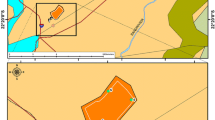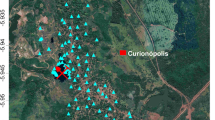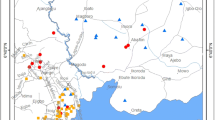Abstract
The Bétaré Oya gold district is situated in the Lom Basin, one of Cameroon’s Neoproterozoic volcano-sedimentary basins. The aim of this study was to evaluate the speciation, bioavailability and potential risk of metals in mine tailing of Bétaré Oya gold district. The metal content of the mine tailing samples collected is evaluated using an Inductive Coupled Plasma-Optical Emission Spectrometer. Speciation was performed according to the Tessier sequential extraction procedure. The low presence of clay in the tailings of the study area reduces the adsorption and mobilization of metals. Pyrite was the dominant sulphide mineral present in the study area. Metal speciation shows that greater portion of metals are bound to Fe–Mn oxide, and decrease progressively to inert fraction, organic fraction, carbonate and exchangeable forms. Relatively high mobility factors observed for Cd, Pb, Co, Fe, Zn and Mn at all sampling sites indicate high mobility, reactivity, susceptibility and bioavailability of these metals in the mine tailings studied. The enrichment of Ni, Cd, Cu, Pb, Co, Fe, Zn and Mn in soil and sediments when compared to metal bioavailability in mine tailings can be attributed to intense oxidation and dissolution of sulphide minerals linked to primary gold mineralization, intense weathering and anthropogenic activities. Contamination index, contamination degree, enrichment factor and geo-accumulation index indicate that Cd, La, As, Hg, and Pb may pose an ecological risk. The potential ecological risk assessment shows a low to very high level of ecological risk. The evaluation of metals content and chemical speciation in the study area is necessary to predict their mobility, bioavailability and potential risk to the ecosystem and this study represents the first metal speciation study in gold mines in Cameroon.





Similar content being viewed by others
Availability of Data and Materials
Data obtained during and/or analysed during this study are available from the corresponding author on reasonable request.
References
Milesi JP, Toteu SF, Deschamps Y, Feybesse JL, Lerouge C, Cocherie A (2006) An overview of the geology and major ore deposits of Central Africa: explanatory note for the 1: 4,000,000 map ‘‘geology and major ore deposits of Central Africa. J Afr Earth Sci 44(4):571–595
Kamga MA, Olatubara CO, Ateh MM, Nzali S, Adenikinju A, Mbiatso TY, Ngatcha RB (2018) Perception of the environmental degradation of gold mining on socio-economic variables in Eastern Cameroon. Cameroon 22(2):23
Edjengte DEP, Léopold E, Nga ADB, Ondoa DB, Lucien BB, Armel Z, Ekoa B (2022) Assessment of metallic contamination in soils and sediments in the Bétaré-Oya Gold Artisanal Mine District, East-Cameroon. Annu Res Rev Biol 37(9):1–1737. https://doi.org/10.9734/ARRB/2022/v37i930527
Manga VE, Neba GN, Suh EC (2017) Environmental geochemistry of mine tailings soils in the artisanal gold mining district of Bétaré-Oya, Cameroon. Environ Pollut 6(1):52
Tessier A, Campbell PG, Bisson M (1979) Sequential extraction procedures for the specification of particulate trace metals. Anal Chem 5:84–4855
Babich H, Stotzky G (1980) Environmental factors that influence the toxicity of heavy metals and gaseous pollutants to microorganisms. Crit Rev Microbiol 8:99–145. https://doi.org/10.3109/10408418009081123
Ndubueze EU (2018) Potential of five plant species for phytoremediation of metal-PAH-pesticide contaminated soil. The University of Western Ontario, London
Ayiwouo NM, Mambou LLN, Mache JR, Kingni ST, Ngounouno I (2020) Waters of the Djouzami gold mining site (Adamawa, Cameroon): physicochemical characterization and treatment test by Bana smectite (West, Cameroon). Chem Environ Eng. https://doi.org/10.1016/j.cscee.2020.100016
Mimba ME, Ohba T, Nguemhe FSC, Wirmvem MJ, Numanami N, Aka FT (2017) Seasonal hydrological inputs of major ions and trace metal composition of streams draining the mineralized Lom Basin, East Cameroon: basis for environmental studies. Earth Syst Environ 1:22. https://doi.org/10.1007/s41748-017-0026-6
Omang BO, Suh CE, Lehmann B, Vishiti A, Chombong NN, Fon AN, Egbe JA, Shemang EM (2015) Microchemical signatures of alluvial gold from two contrasting terrains in Cameroon. J Afr Earth Sc 112:1–14
Azeuda NKI, Xie Y, Goldfarb R, Zhong R, Qu Y (2021) Genesis and mineralization style of gold occurrences of the Lower Lom Belt, Betare Oya district, eastern Cameroon. Ore Geol Rev. https://doi.org/10.1016/j.oregeorev.2021.104586(inpress)
Wang W, Cawood PA, Pandit MK, Zhao JH, Zheng JP (2019) No collision between Eastern and Western Gondwana at their northern extent. Geology 47(4):308–312
De Wit MJ, Linol B (2015) Precambrian basement of the Congo Basin and its flanking terrains. In: de Wit MJ et al (eds) Geology and resource potential of the Congo Basin, regional geology reviews. Springer, Berlin, pp 19–37. https://doi.org/10.1007/978-3-642-29482-2_2
Tata E, Suh CE, Vishiti A, Shemang EM, Fon AN, Ateh KI, Chombong NN (2018) Wallrock alteration categories and their geochemical signatures in gold-bearing Neoproterozoic granitoids, Batouri gold district, southeastern Cameroon. J Geochem Explor Environ Anal. https://doi.org/10.1144/geea2016-017
Ngoniri AH, Djomo HD, Ngnotue T, Kenne PA, Mbianya GN, Ganno S, Nzenti JP (2021) Zircon trace element geochemistry and Ti-in-Zircon thermometry of the Ngazi-Tina Pan-African Post-Collisional Granitoids, Adamawa Cameroon. Int J Geosci 12:307–328. https://doi.org/10.4236/ijg.2021.124017
Tchakounté JN, Eglinger A, Toteu SF, Zeh A, Nkoumbou C, Mvondo-Ondoa J, Penaye J, Wit M, Barbey P (2017) The Adamawa-Yad´ e domain, a piece of Archaean crust in the Neoproterozoic Central African Orogenic belt (Bafia area, Cameroon). Prec Res 299:210–229. https://doi.org/10.1016/j.precamres.2017.07.001
Suh CE, Lehmann B, Mafany GT (2006) Geology and geochemical aspects of lode Gold mineralization at Dimako-Mboscorro. SE Cameroon 6:295–309. https://doi.org/10.1144/1467-7873/06-110
Fils SCN, Mimba MEE, Nyeck B, Nforba MT, Kankeu B, Nouck PN, Hell JV (2020) GIS-based spatial analysis of regional-scale structural controls on gold mineralization along the Betare-Oya shear zone, eastern Cameroon. Nat Resour Res. https://doi.org/10.1007/s11053-020-09695-3
Fon A, Suh CE, Akumbom V, Ngatcha RB, Cho NT, Mutum Shemang E, Ashu Egbe J, Lehmann B (2021) Gold dispersion in tropical weathering profiles at the Belikombone gold anomaly (Betare Oya gold district). East Cameroon. https://doi.org/10.1016/j.chemer.2021.1257702021.125770
Morrison GW, Rose WJ, Jaireth S (1991) Geological and geochemical controls on the silver content (fineness) of gold in gold–silver deposits. Ore Geol Rev 6:333–343
LaPlaine P (1969) Indices minéreax et resources minérales du Cameroon. In bulletin de la direction des mines et de la géologie No. 5, République fédérale du Cameroon
Mimba ME, Nforba MT, Suh CE (2014) Geochemical dispersion of Au in stream sediments in the Paleoproterozoic Nyong Series, southern Cameroon. Sci Re 2(6):155–165
Funoh KN (2014) The impacts of artisanal gold mining on local livelihoods and the environment in the forested areas of Cameroon. Working Paper 150. Bogor, Indonesia: CIFOR
Nodem V, Bamenjo JN, Schwartz B (2012) Sub national natural resource revenue management in Cameroon: Forest and mining Royalities in Yokadouma, east Cameroun. Network for the Fight against Hunger, Yaoundé
Narwal RP, Singh BR, Salbu B (1999) Association of cadmium, zinc, copper and nickel with components in naturally heavy metal rich soils studied by parallel and sequential extraction. Commun Soil Sci Plant Anal 30:1209–1230
Singh BR, Kabala C (2001) Fractionation and mobility of copper, lead, and zinc in soil profiles in the vicinity of a copper smelter. J Environ Qual 30:485–492
McLennan SM, Taylor SR (2001) Hemming, composition, differentiation and evolution of continental crust: constraints from sedimentary rocks and heat flow. In: Brown M, Rusher T (eds) Evolution and differentiation of the continental crust. Cambridge University Press, New York
Hakanson L (1980) An ecological risk index for aquatic pollution control. Sedimentol Approach Water Res 14(8):975–1001
Gao J, Du F, Li W, Han J, Wang X, Bao J et al. (2016) Content and accumulation characteristics of heavy metals in dominant plants in Xiao Bai He Area of the Yellow River Wetland. J Agro-Environ Sci 11:2180–2186. https://doi.org/10.11654/jaes.2016-0335
Tariq J, Nasir A, Azhar M (2018) Heavy metals contamination and ecological risk assessment in surface sediments of Namal Lake, Pakistan. Pol J Environ Stud 27:681–688. https://doi.org/10.15244/pjoes/75815
Müller G (1981) The heavy metal content of the sediments of the Neckar and its tributaries: An inventory. Chemische Zeitung 105:157–161
Hazama K, Nagata S, Fujimori T, Yanagisawa S, Yoneyama T (2015) Concentrations of metals and potential metal-binding compounds and speciation of Cd, Zn and Cu in phloem and xylem saps from castor bean plants (Ricinus communis) treated with four levels of cadmium. Physiol Plant 154:243–255
Horsfall M, Spiff A (2005) Speciation and bioavailability of heavy metals in sediment of Diobu River, Port Harcourt. Nigeria Eur j Sci Res 6:20-36I
Gabarrón M, Zornoza R, Martínez S, Muñoz VA, Faz Á, Acosta JA (2019) Effect of land use and soil properties in the feasibility of two sequential extraction procedures for metals fractionation. Chemosphere 218:266–272
Cuong DT, Obbard JP (2006) Metal speciation in coastal marine sediments from Singapore using a modified bcr-sequential extraction procedure. Appl Geochem 21:1335–1346
Zeng XF et al (2015) Removal of trace metals and improvement of dredged sediment dewaterability by bioleaching combined with Fenton-like reaction. J Hazard Mater 288:51–59
Osakwe OV, Akpoveta BE, Okoh OK (2012) Chemical forms of heavy metals in soils around municipal waste dumpsites in Asaba Metropolis, Delta State, Nigeria. Chem Speciat Bioavail 24:23–30
Tesi GO, Joshua OO, Samuel OA (2020) Chemical speciation and mobility of heavy metals in soils of refuse dumpsites in some urban towns in the Niger Delta of Nigeria, pp 66–72. https://doi.org/10.2478/auoc-2020-0013
Ashraf M, Maah M, Yusoff I (2012) Chemical speciation and potential mobility of heavy metals in the soil of former tin mining catchment. Sci World J 2012:125608
Riaz M, Kamran M, Rizwan M, Ali S, Parveen A, Malik Z, Wang X (2021) Cadmium uptake and translocation: synergetic roles of selenium and silicon in Cd detoxification for the production of low Cd crops: a critical review. Chemosphere. https://doi.org/10.1016/j.chemosphere.2021.129690
Jiang D, Zhou Y, Tan M, Zhang J, Guo Q, Yan S (2020) Cd exposure-induced growth retardation involves in energy metabolism disorder of midgut tissues in the gypsy moth larvae. Environ Pollut 266:115–173
Iwegbue CMA, Emuh FN, Isirimah NO, Egun AC (2007) Fractionation, characterization and speciation of heavy metals in composts and compost-amended soils. Afr J Biotechnol 6:67–78
Wang S, Jia Y, Wang S, Wang X, Wang H, Liu B (2010) Fractionation of heavy metals in shallow marine sediments from Jinzhou Bay, China. J Environ Sci. https://doi.org/10.1016/S1001-0742(09)60070-X
Nemati K, Abu Bakar NK, Radzi Abas M, Sobhanzadeh E (2011) Speciation of heavy metals by modified BCR sequential extraction procedure in different depths of sediments from Sungai Buloh, Selangor, Malaysia. J Hazard Mater 192(1):402–410
Wali A, Colinet G, Ksibi M (2015) Speciation of heavy metals by modified BCR sequential extraction in soils contaminated by phosphogypsum in Sfax, Tunisia. Environ Res Eng Manag 70(4):14–25
Abollino O, Malandrino M, Giacomino A, Mentasti E (2011) The role of chemometrics in single and sequential extraction assays: a review. Anal Chim Acta 688:104–121
Akinyemi SA, Akinlua A, Gitari WM, Nyale SM, Akinyeye RO, Petrik LF (2012) An investigative study on the chemical, morphological and mineralogical alterations of dry disposed fly ash during sequential chemical extraction. Energy Sci Technol 3:28–37
Hickey MG, Kittrick JA (1984) Chemical partitioning of cadmium, copper, nickel and zinc in soils and sediments containing high levels of heavy metals. J Environ Qual 13:372–376
Lopez-Sanchez F, Rubio R, Samitier C (1996) Trace metal partitioning in marine sediments and sludges deposited off the coast of Barcelona (Spain). Water Res 30:153–159
Ateh KI, Suh CE, Shemang EM, Vishiti A, Tata E, Chombong NN (2017) New LA-ICP-MS U-Pb ages, Lu-Hf systematics and REE characterization of zircons from a granitic pluton in the Bétaré Oya gold district, SE Cameroon. J Geosci Geol 5:267–283
Feketeova Z, Hulejova V, Sladkovicova MB, Simkovic I (2015) Biological activity of the metal-rich post-flotation tailings at an abandoned mine tailings pond (four decades after experimental afforestation). J Environ Sci Pollut Res 22:12174–12181
Ajala LO, Onwukeme VI, Mgbemena MN (2014) Speciation of some trace metals in floodplain soil of Eke-Mgbom, Afikpo, Nigeria. J Am Chem Sci 4:963–974
Papafilippaki AK, Kotti ME, Stavroulakis GG (2008) Seasonal variation in dissolved heavy metals in the Keritis River, Chania, Greece. Global NEST J 10:320–325
Osakwe SA (2012) Chemical partitioning of iron, cadmium, nickel and chromium in contaminated soils of South-Eastern, Nigeria. Res J Chem Sci 2:1–9
Osakwe SA (2010) Chemical speciation and mobility of some heavy metals in soils around automobile waste dumpsites in Northern part of Niger Delta, South Central Nigeria. J Appl Sci Environ Manage 14(4):123–130
Iwegbue CMA, Tesi LC, Overah GE, Nwajei BS (2018) Chemical fractionation and mobility of metals in floodplain soils of the lower reaches of River Niger, Nigeria. Trans R Soc S Afr 73:90109. https://doi.org/10.1080/0035919X.2017.1361483
Mimba ME, Ohba T, Nguemhe FSC et al (2018) Regional geochemical baseline concentration of potentially toxic trace metals in the mineralized Lom Basin, East Cameroon: a tool for contamination assessment. Geochem Trans. https://doi.org/10.1186/s12932-0056-5
Acknowledgements
This study is part of the first author’s ongoing PhD research at The University of Bamenda.
Funding
No funding received for this study.
Author information
Authors and Affiliations
Contributions
All authors contributed to the study conception and design. Material preparation, data collection and analysis were performed by LPY, CES, TAM, MEM and NMJL. The first draft of the manuscript was written by LPY. Further modifications were made by CES, MEM and TAM. All authors have read and approved the final manuscript.
Corresponding author
Ethics declarations
Conflict of interest
The authors declare that they have no conflict of interest.
Rights and permissions
Springer Nature or its licensor (e.g. a society or other partner) holds exclusive rights to this article under a publishing agreement with the author(s) or other rightsholder(s); author self-archiving of the accepted manuscript version of this article is solely governed by the terms of such publishing agreement and applicable law.
About this article
Cite this article
Yiika, L.P., Tita, M.A., Suh, C.E. et al. Heavy Metal Speciation by Tessier Sequential Extraction Applied to Artisanal Gold Mine Tailings in Eastern Cameroon. Chemistry Africa 6, 2705–2723 (2023). https://doi.org/10.1007/s42250-023-00652-0
Received:
Accepted:
Published:
Issue Date:
DOI: https://doi.org/10.1007/s42250-023-00652-0




